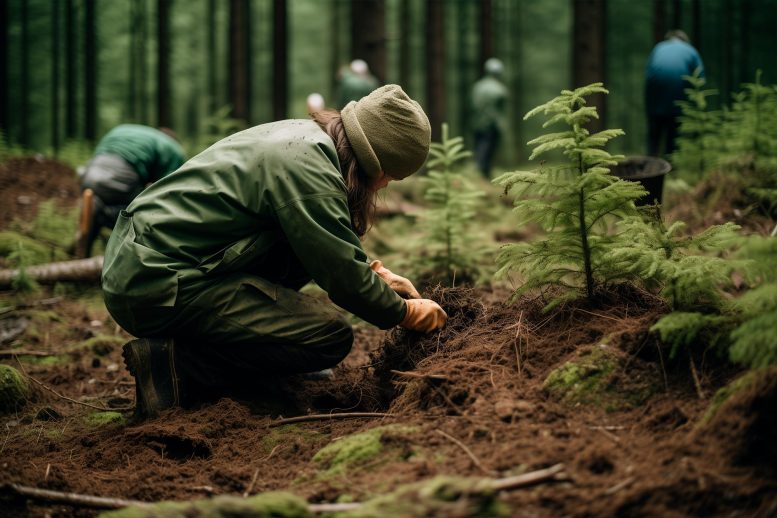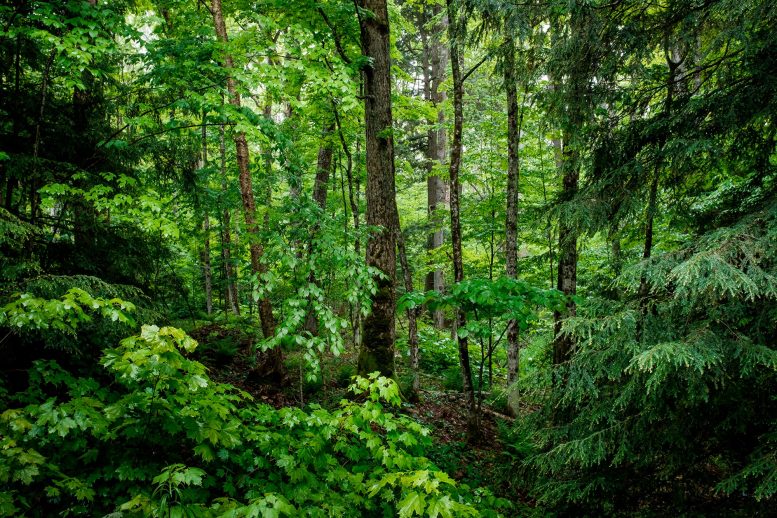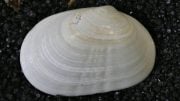
An international study has found that mixed forests store more carbon than monocultures, with four-species mixtures being the most effective. Mixed forests are not only more resilient to environmental threats but also provide greater ecosystem services and biodiversity. Despite these benefits, many countries focus on single-species forest restoration.
Above ground carbon stocks are at least 70% higher in mixed forests than in monocultures, with the highest carbon stocks relative to monocultures in forests comprised of four species.
Forests are excellent at absorbing and storing carbon and can play a role in meeting global net zero targets. As more countries commit to forest creation, but mainly plant single species forests, an international team of researchers has examined how carbon stocks in mixed forests and monocultures compare. They found that mixed forests store more carbon, and that out of the forests assessed those with four species had the highest carbon stocks relative to monocultures.
Forests with multiple tree species are 70% more effective as carbon sinks than monoculture forests.
To slow the effects of climate change, conserve biodiversity, and meet the sustainable development goals, replanting trees is vital. Restored forests store carbon within the forest’s soil, shrubs, and trees. Mixed forests are especially effective at carbon storage, as different species with complementary traits can increase overall carbon storage. Compared to single-species forests, mixed forests are also more resilient to pests, diseases, and climatic disturbances, which increases their long-term carbon storage potential. The delivery of other ecosystem services is also greater in mixed-species forests, and they support higher levels of biodiversity.

Research reveals that mixed forests, particularly those with four species, store more carbon than monocultures and offer greater ecological benefits. Despite the advantages of species diversity, current forest restoration efforts largely favor monocultures.
Current Forest Restoration Practices
Although the benefits of diverse forest systems are well known, many countries’ restoration commitments are focused on establishing monoculture plantations. Given this practice, an international team of scientists has compared carbon stocks in mixed planted forests to carbon stocks in commercial and best-performing monocultures, as well as the average of monocultures.
“Diverse planted forests store more carbon than monocultures – upwards of 70%,” said Dr Emily Warner, a postdoctoral researcher in ecology and biodiversity science at the Department of Biology, University of Oxford, and first author of the study published in Frontiers in Forests and Global Change. “We also found the greatest increase in carbon storage relative to monocultures in four-species mixtures.”
Research Findings on Species Richness
The researchers analyzed studies published since 1975 that directly compared carbon storage in mixed and single-species forests, and combined this with previously unpublished data from a global network of tree diversity experiments. “We wanted to pull together and assess the existing evidence to determine whether forest diversification provides carbon storage benefits,” Warner explained.
The mixed planted forests assessed in the study ranged in species richness from two to six species. In the dataset the scientists worked with, four-species mixtures were the most effective carbon sinks. One such mix was made up from different broadleaf trees which can be found across Europe. Mixes with two species also had greater aboveground carbon stocks than monocultures and stored up to 35% more carbon. Forests made up of six species, however, showed no clear advantage to monocultures. Accordingly, the researchers were able to show that diversification of forests enhances carbon storage. Altogether, aboveground carbon stocks in mixed forests were 70% higher than in the average monoculture. The researchers also found that mixed forests had 77% higher carbon stocks than commercial monocultures, made up of species bred to be particularly high-yielding.
Future Forest Management Implications
“As momentum for tree planting grows, our study highlights that mixed species plantations would increase carbon storage alongside other benefits of diversifying planted forests,” said Dr Susan Cook-Patton, a senior forest restoration scientist at The Nature Conservancy and collaborator on the study. The results are particularly relevant to forest managers, showing that there is a productivity incentive for diversifying new planted forests, the researchers pointed out.
While showing the increased potential of mixed forests to store more carbon, the researchers cautioned that their study is not without limitations, including the overall limited availability of studies addressing mixed vs monoculture forests, particularly studies from older forests and with higher levels of tree diversity.
“This study demonstrates the potential of diversification of planted forests, and also the need for long-term experimental data to explore the mechanisms behind our results,” Warner said. “There is an urgent need to explore further how the carbon storage benefits of diversification change depending on factors such as location, species used, and forest age.”
Reference: “Young mixed planted forests store more carbon than monocultures—a meta-analysis” by Emily Warner, Susan C. Cook-Patton, Owen T. Lewis, Nick Brown, Julia Koricheva, Nico Eisenhauer, Olga Ferlian, Dominique Gravel, Jefferson S. Hall, Hervé Jactel, Carolina Mayoral, Céline Meredieu, Christian Messier, Alain Paquette, William C. Parker, Catherine Potvin, Peter B. Reich and Andy Hector, 9 November 2023, Frontiers in Forests and Global Change.
DOI: 10.3389/ffgc.2023.1226514









Be the first to comment on "70% More Effective: The Carbon-Sinking Superpower of Multi-Species Forests"